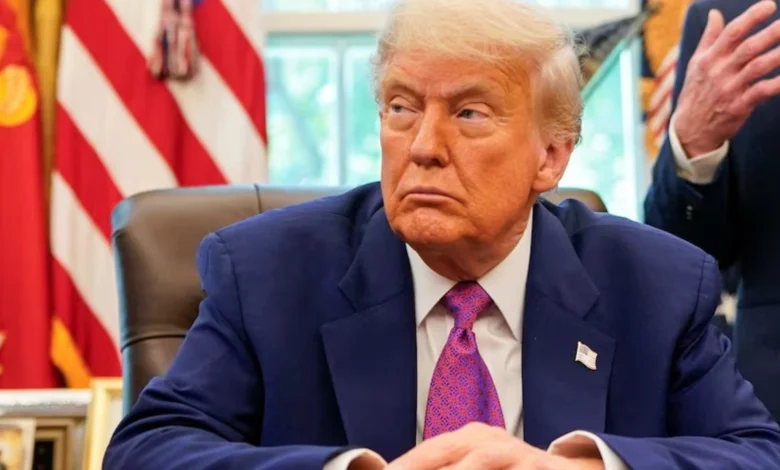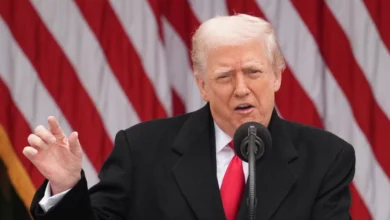Trump Hikes Tariffs on 14 Countries including India, Japan and Bangladesh

| Get instant news updates: Click here to join our Whatsapp Group |
Trump Hikes Tariffs on 14 Countries: On Monday, former US President Donald Trump announced that the United States will increase import tariffs on goods from 14 countries, including Bangladesh, Japan, and South Korea. His administration has formally notified these countries by sending official letters.

Tariff on 14 Countries
| Country | Proposed Tariff (April 9) | Announced Tariff (July 7) | Share in US Imports |
|---|---|---|---|
| Japan | 24% | 25% | 4.50% |
| South Korea | 25% | 25% | 4.00% |
| Thailand | 36% | 36% | 1.90% |
| Malaysia | 24% | 25% | 1.60% |
| Indonesia | 32% | 32% | <1% |
| South Africa | 30% | 30% | <1% |
| Cambodia | 49% | 36% | <1% |
| Bangladesh | 37% | 35% | <1% |
| Kazakhstan | 27% | 25% | <1% |
| Tunisia | 28% | 25% | <1% |
| Serbia | 37% | 35% | <1% |
| Laos | 48% | 40% | <1% |
| Myanmar | 44% | 40% | <1% |
| Bosnia and Herzegovina | 35% | 30% | <1% |
What Are the New Tariffs?
Trump’s decision includes the imposition of 25% to 40% tariffs on certain goods coming from these countries:
- 25% tax on some countries like Japan and South Korea
- 30% to 40% tax on others, depending on the product
These new tariffs will come into effect from August 1, 2025. Initially, Trump had planned to implement them on July 9, but the deadline was extended to give countries time to negotiate new trade agreements with the US.
Why Are These Tariffs Being Imposed?
Trump stated that these taxes are necessary to correct the trade imbalance between the United States and these countries. According to him, many countries have been exporting more to the US while buying less in return, creating unfair trade conditions.
Trump’s Previous Tariff Plans
In April 2025, Trump had proposed a 10% baseline tariff on all imported goods into the US, along with additional taxes on 60 specific countries. However, after this announcement, global stock and bond markets became unstable. As a result, he decided to pause the tariff implementation for 90 days, allowing time for new trade deals to be made. The initial deadline to finalize deals was July 8, but this has now been pushed to August 1, 2025.
Trade Talks and Global Reactions
According to The New York Times, Trump may announce new trade deals with several countries this week. Talks with India are in advanced stages, and a deal may be announced soon.
- The European Union (EU) is also close to reaching a trade agreement with the US.
- Other countries like Pakistan, Taiwan, and Switzerland are exploring trade partnerships as well.
Initial Trade Deals Already Made
So far, the US has signed two initial trade agreements with:
- United Kingdom:
- 10% US tariff on UK goods
- Additional 25% duty on UK steel and aluminum
- UK will impose 0% tariff on American products
- Vietnam:
- 20% US tariff on Vietnamese goods
- Vietnam will impose 0% tariff on US imports
However, the details of these deals remain unclear.
China Strongly Opposes US Tariff Strategy
China, a key BRICS nation, has criticized the US move. Chinese Foreign Ministry spokesperson Mao Ning said that tariffs and trade wars harm global cooperation. He emphasized that BRICS supports fair international trade and warned against political pressure through trade threats.
US Claims 90 Countries Ready for Deals
US Finance Minister Scott Besant said that around 90 countries have shown interest in signing trade deals with the US. He claimed the White House has received a large number of proposals from nations eager to reach agreements before the tariff deadline. Besant added that the US aims to encourage healthy and open trade relations, and it is open to deals with any country willing to cooperate.
India-US Trade Deal: What’s Happening?
Negotiations are ongoing between India and the United States. If an agreement is not finalized by August 1, India could face a 26% tariff on its exports to the US. Teams from both sides are in Washington, working hard to finalize the agreement. Indian Commerce Minister Piyush Goyal stated that India’s national interests will not be compromised.
What Benefits Could India Get?
If the deal goes through, here’s how India would benefit:
- Indian exports like textiles, medicines, and jewelry will have better access to the US market
- Removal of the 26% tariff will make Indian goods cheaper in the US
- It may boost India-US bilateral trade to $500 billion by 2030
Benefits for the US:
- Easier access to sell goods like pecan nuts, blueberries, and vehicles in the Indian market
- A stronger strategic partnership with India, especially important in the Asia-Pacific region
This agreement could also pave the way for a larger Free Trade Agreement (FTA) in the future.
What Are the Challenges in the Deal?
There have been some key obstacles in the India-US trade negotiations:
- Agriculture and Dairy Products:
- The US wants to export genetically modified (GM) crops and dairy items to India.
- India has rejected this demand due to safety and ethical concerns.
- Tariff Differences:
- India wants the US to remove the full 26% and 10% tariffs.
- The US is firm on keeping at least a 10% baseline tariff.
- Political Pressure:
- Trump warned countries to sign deals by July 9 or face tariffs.
- India made it clear it would not bow to pressure and would decide based on its own interests.
Geopolitical Importance of the Deal
This trade agreement isn’t just about economics. It also has geopolitical importance:
- Strategic Alliance Against China: A strong India-US partnership will help counter China’s growing influence in the Asia-Pacific region. The deal also supports cooperation under Quad (India, US, Japan, Australia).
- Russia and Oil: The US is concerned about India buying cheap oil from Russia. Trump has proposed a 500% tariff on countries trading with Russia. This deal might offer some flexibility to India regarding oil imports.
The US is taking a tough stance on trade, aiming to balance its imports and exports through tariffs and bilateral deals. While this has created tensions, it has also opened up new negotiation opportunities for many countries, including India. If India and the US successfully sign a mini trade deal, it could bring long-term benefits for both countries and may lead to a full Free Trade Agreement in the future.
